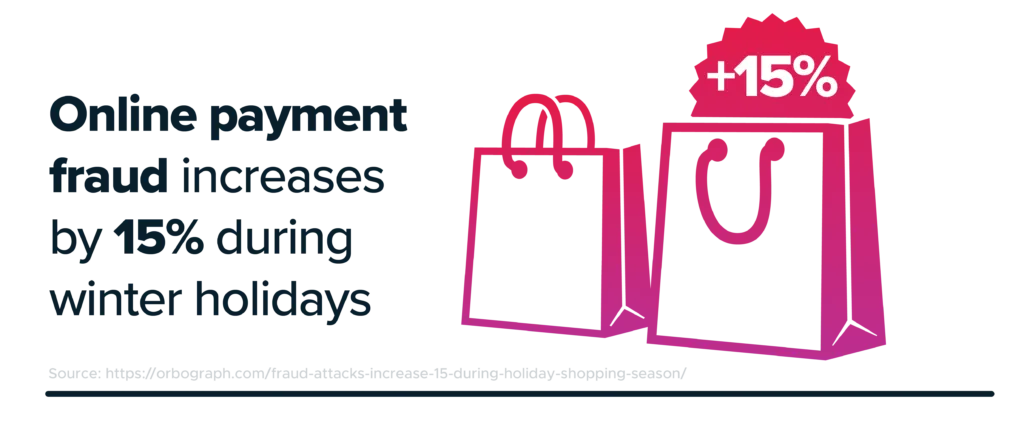Q4 is undoubtedly the most pivotal time of the year for eCommerce businesses as 90% of their best selling days fall into a short window of just a few weeks. Yet, as the rush of online shoppers escalates, so does the complexity of managing payments. For online retailers and marketplaces, the fourth quarter isn't ; it's about shaping the brands’ profitability for the entire year. While most businesses are aware of generic challenges like their website uptime or inventory and shipping management, there are payment-specific hurdles that can often go unnoticed, while they eat into companies’ profits during this crucial period. In this article, we address the top 3 payment challenges and solutions for eCommerce businesses that can be the difference between a successful holiday season and lost revenue opportunities.
Optimizing authorization rates and reducing payment declines
Not all payment gateways are created equal, and during peak traffic, transaction failures can increase. This happens for multiple reasons, including payment processors’ uptime, the choice of payment rails, banks’ working hours during holiday season. With 58% of shoppers willing to wait for discounts and flash sales to make a purchase, retailers risk losing revenue as consumer activity spikes due to slow processing times and false declines. A staggering 62% of consumers who experienced a declined online transaction will give up their purchase with a brand, which can cost billions in lost revenue to merchants.

Here are a few ways payment technology can come to the rescue, helping eCommerce make the most of holidays:
- Smart transaction routing can be a game-changer for online retailers experiencing an overwhelming amount of card payments. Instead of directing all transactions through a single gateway, this technology assesses each transaction's profile and cascades it to the relevant acquirer that is most likely to approve it, reducing soft declines and optimizing cost efficiency. This dynamic approach significantly enhances authorization rates, ensuring that businesses capture every possible sale without retries.
- Decline recovery is the feature a retailer’s payment partner must have as it’s designed for converting declined transactions into successful sales. This can include suggesting another payment option, providing support contact information, or even allowing the customer to suggest a new amount. These options give customers the opportunity to complete their purchase, by giving the transaction more chances to get approved should a soft decline happen.
- Partial approvals can also help online retails increase retention and sales. As consumers risk overspending during peak seasons, 27% of all declined transactions happen due to insufficient funds. Partial approvals identify these transactions before the issuer declines them and offers the customer the option to deposit a lower value that will be approved, leading to increased conversion rates.
Striking the balance between security and user experience
With increased transaction volumes, the holiday season also witnesses a spike in fraudulent activities. The festive time of year sees an average of 15% more online payment fraud compared to other months. But, in a bid to counteract fraud, many platforms overshoot and end up rejecting genuine transactions. Over 60% of eCommerce businesses report an increase in their false decline rates. With fraudulent activity, the consumer seeks support from their bank that is liable for the lost funds. In the case of false declines, however, the losses are entirely on the merchant’s side, leading to both customer dissatisfaction and revenue drain.

An expert approach to risk management is essential, and the right payment partner can help build a successful strategy. It isn't about leaning solely towards fraud prevention or exclusively focusing on reducing false declines.
The ideal solution is a balanced one, and here's how:
- Strategic application of Strong Customer Authentication (SCA) - Because SCA includes multifactor authentication, it can add friction into the approval process. To mitigate the impact on conversion rates, companies can employ exemption rules that bypass the need for multi-factor authentication where the risk of fraud is low. This approach meets Strong Customer Authentication requirements under PSD2 regulations. It is also relevant to regions not covered by PSD2 as card schemes are looking to implement 3DS2 protocols in those territories.
- Network tokenization - It replaces sensitive card details with unique tokens, ensuring that even if transaction data is intercepted, it's of no value to fraudsters. Successful implementation of network tokenization can reduce fraudulent attempts by up to 30%. This not only enhances security but can also increase authorization rates, as tokenized transactions are often viewed as lower risk.
- Leveraging AI tools - Advanced AI tools can process vast amounts of payment data in real-time, learning and adapting from each transaction. Generative AI, paired with payment technology expertise, discerns patterns that might be invisible to manual checks, helping to identify legitimate transactions and reduce false declines.

The hidden revenue trap - dynamic currency conversion and localized pricing
As online shopping becomes increasingly borderless, international shoppers are becoming a significant audience for most businesses – on average, 57% of consumers already shop internationally. While presenting prices in a foreign currency is preferred by 92% of all online buyers, 33% would walk away if the price is displayed in US dollars only. The added hassle of currency conversion and the uncertainty of the final amount can lead to abandoned carts too.

The solution for eCommerce brands is twofold. Firstly, businesses can implement Dynamic Currency Conversion (DCC), allowing customers to see prices and make payments in their preferred currency, while minimizing double-conversion which can add up to a sizeable transaction fee. Secondly, retailers can utilize localized pricing to ensure prices resonate with local market expectations. By partnering with a payment technology provider with extensive expertise in this area, businesses can localize their pricing and payment strategy seamlessly, enhancing customer trust and boosting conversion rates.
Balancing profit with payment complexity
The peak shopping season is a tightrope walk for eCommerce businesses, balancing the surge in sales with the complexities of payment management. By recognizing the less obvious pain points and leveraging advanced payment technology solutions, online retailers and marketplaces can ensure that their holiday season is as positive for their P&L as it is for their customers.
.svg)
Payments designed to accelerate your business
Choose Nuvei for payments that work harder to convert sales and boost your bottom line.



.webp)

